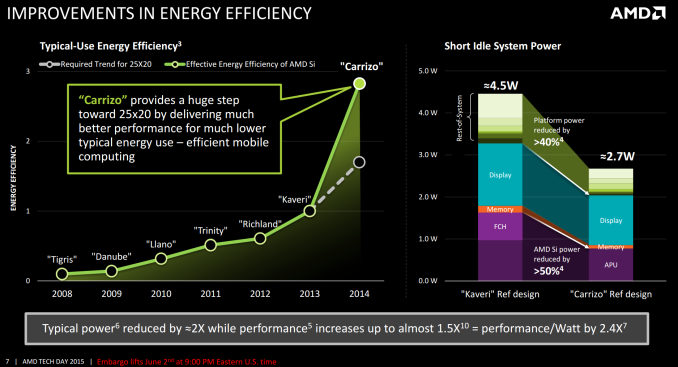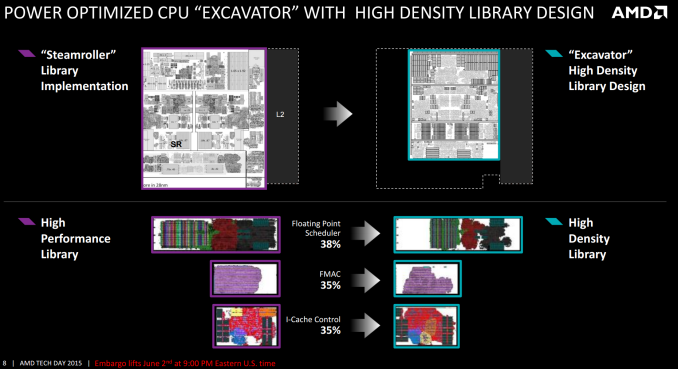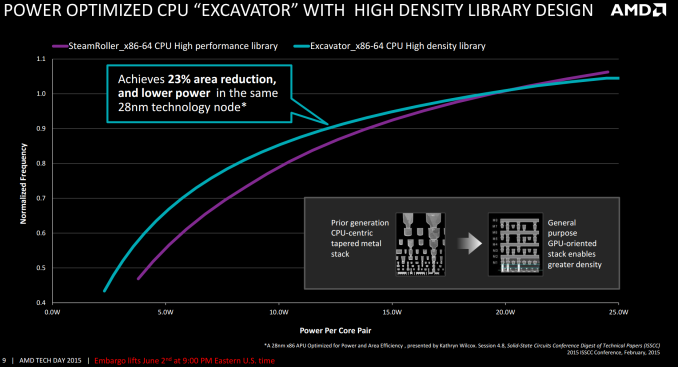AMD Launches Carrizo: The Laptop Leap of Efficiency and Architecture Updates
by Ian Cutress on June 2, 2015 9:00 PM ESTEfficiency and Die Area Savings
AMD’s take home message in all of this is efficiency. We a being quoted a performance per watt increase of 2.4x, coming from typical power draw savings of 2x and performance increase of almost 1.5x for 23% less die area, all in one go.
Ultimately this all helps AMD’s plan to be 25x more efficient with their APUs by 2020, and the cumulative bar chart on the right is how mobile improvements from all sides are being realized. Migrating the southbridge on die severely reduces its idle power consumption to almost zero and can help efficiencies elsewhere in the system. The APU general use and memory controllers are the next targets, but the common constant here is the display. Using a low power display might give battery life in exchange for quality, and there is only so much power you can save at the SoC level. In time, the display will be the main focus of power saving for these devices.
A big part of the reduction in die area comes from the set of high density libraries being used by AMD. Above were three examples provided where >33% gains were made in silicon area. Typically using a high density library design is a double edged sword – it reduces die area and potentially leaves more area for other things, but the caveat is that it may be more prone to defects in construction, require additional latency or have a different frequency/voltage profile. AMD assures us that these changes are at least like-for-like but most of them contain other improvements as well.
It’s worth noting here that AMD has described the high density library project internally as the equivalent of a moonshot, essentially the developers were part of a ‘skunkworks’ division attempting to make drastic changes in order to improve performance. The high density library is one such successful project from that.
With the new libraries, comparing Excavator to Steamroller shows the effect moving designs has. The power/frequency curve below 20W per module shifts to higher frequency/lower power, whereas losses are observed above 20W. However for 15W per module, this means either a 10%+ power reduction at the same frequency or a 5% increase in frequency for the same power. Should AMD release dual thread / single core APUs in the 7.5W region, this is where most of the gains are (as noted in the comments, the dual module designs are at 7.5W per module, meaning that what we should see in devices is already in the peak value for gains and benefits such as 25% frequency or 33% power). As also seen in the insert, the silicon stack has been adjusted to a more general purpose orientation. I could comment that this makes the CPU and GPU work better together, but I have no way of verifying this. AMD states the change in the silicon stack makes production slightly easier but also helps with achieving the higher density Excavator exhibits.













137 Comments
View All Comments
yankeeDDL - Wednesday, June 3, 2015 - link
If you think as gaming as hard-core gaming, latest and greatest titles, max settings, high res, then yes, I agree.But, as a father, I can tell you that there are tons of kids that are OK with "some" gaming and for whom the parents won't fork 1Kusd for a powerful gaming rig, and for which AMD really offers a price/performance ratio that cannot be compared.
FlushedBubblyJock - Tuesday, June 9, 2015 - link
having kids in usa is down down down, so not so much biz therebarleyguy - Thursday, June 4, 2015 - link
The marketing for this particular launch is specifically targeting players of MOBAs, such as League of Legends, DOTA2, and Starcraft. The active players of those 3 games is about 100 million people. You can argue that's not a majority of users, but AMD has never had a majority share of laptops, and 100 million people is a sizable market.I expect that AMD will make more direct appeals for that group of people, such as sponsoring tournaments, and generally trying to establish mindshare for laptops in that group.
I don't think targeting that particular niche market is a bad idea, personally.
Refuge - Thursday, June 4, 2015 - link
Their APU's can perform on those games very well, but also so can all of Intel's HD series graphics, at least every rendition I've ever seen.It won't be an easy crowd to win over. Even if the requirements for their sport only warrant a $300 computer, you know they are gamers and still want their supercomputers.
Magichands8 - Wednesday, June 3, 2015 - link
I agree with this. But it also doesn't make sense to me why they have. CPU's have been commodity devices for some time now and it makes no sense to me whatsoever that the average consumer would buy Intel when they can transparently get the very same performance for their needs with a much cheaper AMD processor. This, plus the fact that AMD does so well with essentially embedded systems (XBox, Playstation) even though they are 'AMD Inside' suggests to me that their struggle is largely due to marketing failures rather than technological ones.medi03 - Thursday, June 4, 2015 - link
Athlon 64th were outsold by Intel's Prescott that was:a) slower
b) consumed more power
c) more expensive
also because of "AMD's marketing failures" I guess...
FlushedBubblyJock - Tuesday, June 9, 2015 - link
no it's the skin that surrounds the amd heart - and that skin is cheap and ugly - that's how amd plays their cards... a low class dirt bucket cheap compile - so even if it could be made to look great and "feel very expensive and well constructed" - those creating AMD skin WON'T DO IT.FlushedBubblyJock - Tuesday, June 9, 2015 - link
Thinking again I will admit when browsing new laptops in person AMD GAMING ! is not something I can ever recall seeing ... it's very tough sometimes just to get the basic specs visible by the box stores....AS118 - Wednesday, June 3, 2015 - link
I don't ind 1366 x 768 on a smaller screen (14" and less for me) and think that AMD's performance on 900p and below's great. I also think that it's sad that more people don't know about them and how capable they are.Many casual customers who would want that extra gaming performance don't even know it exists on A8's and A10's.
AS118 - Saturday, June 6, 2015 - link
Yeah, I don't mind 1366 x 768 myself on smaller laptops, and gaming at that resolution is a thing with AMD APU's. Gaming performance on the A8 and especially A10 APU's is why I've been getting AMD Processors on Laptops for years.I don't need a lot of GPU oomph on my laptops, just needed the option to play casual games and not that hard to run stuff like WoW (well, before WoD at least) on the go.